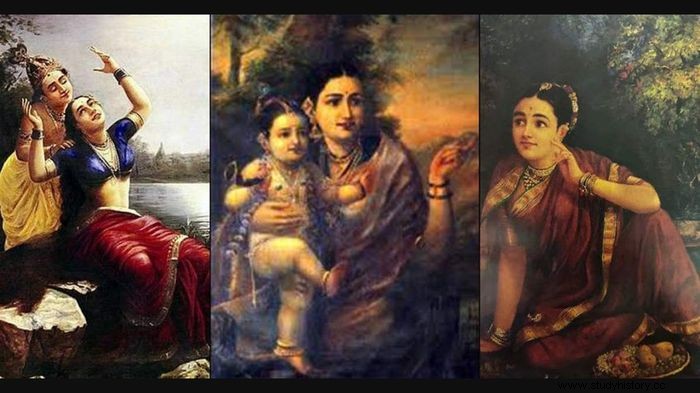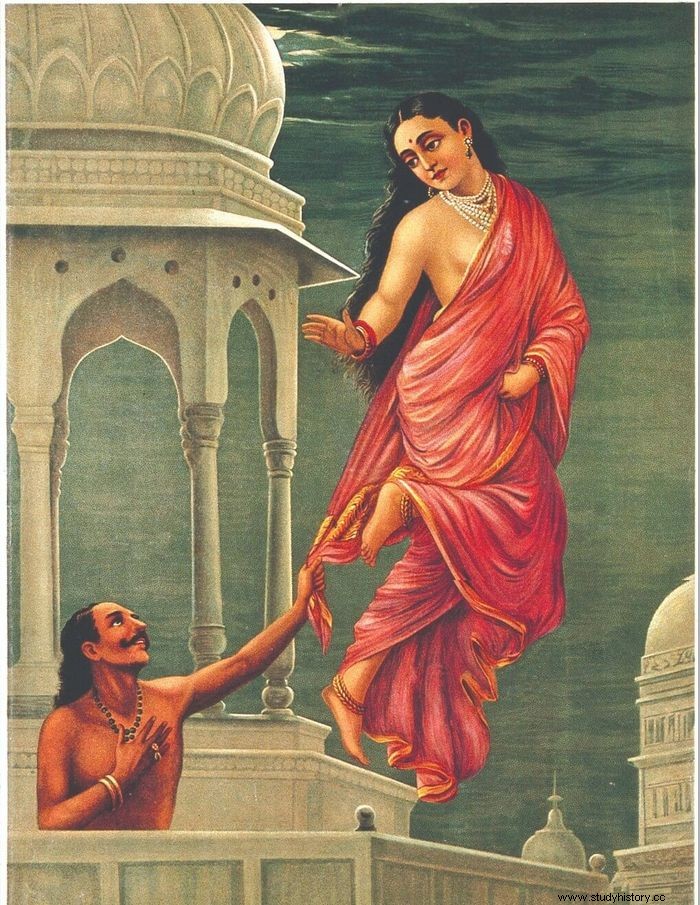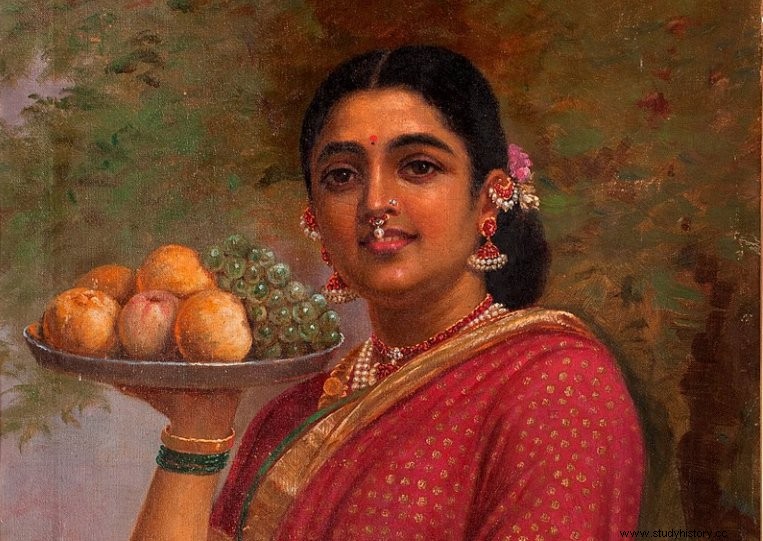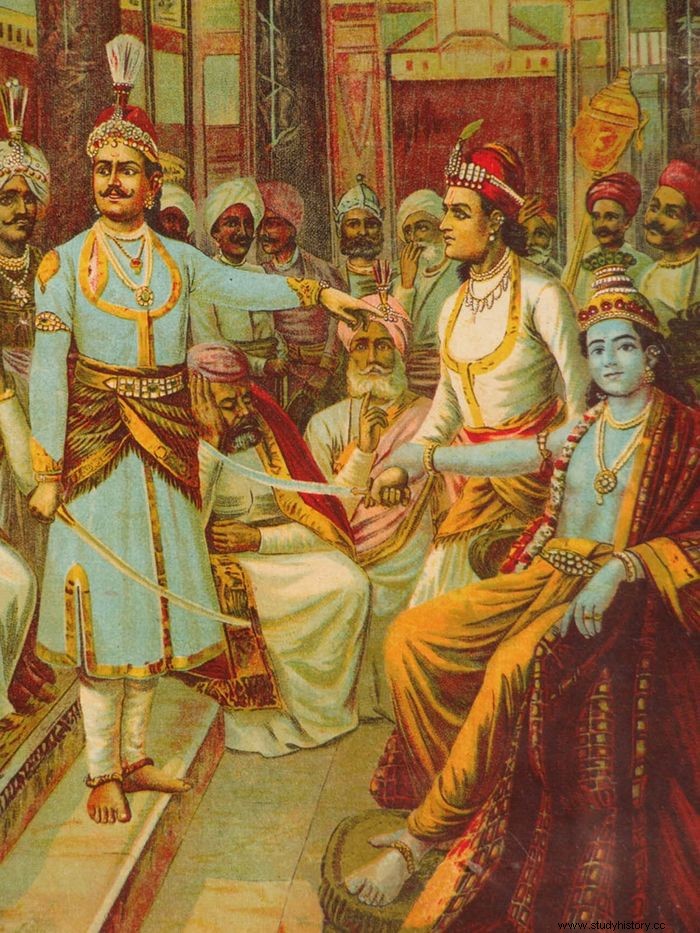Raja Ravi Varma was an Indian painter best known for combining Hindu mythological elements and European realistic historicist painting style. Ravi varma stood out as one of the first Indian artists to work with oil painting and mastered the technique of lithographic printing. Varma produced several portraits of Indians and Britons in India, as well as scenes from Hindu mythology.
In the state of Travancore, Varma was born into an elite family. His uncle Raja Raja Varma, who observed his early enthusiasm for drawing on the palace walls, offered his first rudimentary painting instruction. Varma's artistic career was supported by Maharaja Ayilyam Thirunal, the ruler of Travancore. Soon after, Rama Swamy Naidu, the royal painter, began teaching him to paint with watercolors. Three years later, Varma began studying oil painting with Theodore Jensen, a Danish-born British artist.
The Painter's Life

Raja Ravi Varma married Rani Bhageerathi Bayi (Kochu Panki Amma), a 12-year-old girl from Mavelikkara Royal House when he was 18 years old. He had five children, the youngest of whom, Rama Varma, went on to study art at the JJ School of Arts in Mumbai and became an artist. In recent years, Ravi Varma lived in Mysore, Baroda and several other Indian cities. This exposure helped him broaden his perspective. At the same time, he expanded and refined his talents so that he could become a more productive painter.
Varma was the first Indian artist to apply Western perspectives and compositional techniques to Indian themes, styles and ideas. In 1873, he received the Governor's Gold Medal for his painting Nair Lady Adorning Her Hair. As a result, he became a sought-after artist among the Indian royals and Europeans in India, who commissioned him to paint their portraits.
popularity
Varma became known for his portraits, but he also painted scenes from Indian mythology. In the epics and Puranas, his depictions of Hindu deities and goddesses and characters revealed his immersion in Indian culture. Harischandra in Distress, Jatayu Vadha and Shri Rama Vanquishing the Sea were among his paintings that represented dramatic episodes from Indian mythology. His representations of Indian women were so well received that a beautiful woman was often characterized as looking "as if she were stepping out of a Varma canvas."
Varma transformed Western realism into an Indian art movement. In 1894, he established a lithographic press to mass-produce oleographies of his paintings, making them affordable for the general public. His pictures grew in popularity due to this innovation, and they became an important part of popular Indian culture.
Later artists rebuked Varma, claiming that his work was only superficially Indian since it copied Western painting approaches despite depicting mythological Indian themes. This view influenced the establishment of the Bengal School of Art (also known as the Bengal School), whose members combined traditional Indian creative traditions with a modernist perspective
Despite some rejecting Varma's work as "calendar art", his work has maintained a steady level of popularity. The Begum's Bath, for example, was sold for a record sum for an Indian artist in 1997. In addition, Varma's sense of beauty and grace can be seen in works such as The Maharashtrian Lady, Shakuntala, The Milkmaid, Expectation and Pleasing.
Raja Ravi Varma - the painter

With his excellent skill, Varma was also responsible for bringing Indian art to the rest of the globe. While Europeans and other art enthusiasts admired his technique, ordinary Indians appreciated his work for its simplicity. Varma's paintings often emphasized the beauty of South Indian women, who were loved by all. Many individuals from the lowest castes turned to his depictions of Hindu deities and goddesses as worship material. These people were often barred from accessing the temples at that time. Therefore, they praised Varma's work since they showed how the gods appeared in the temple.
He also succeeded in developing artistic understanding and raising awareness of the value of art among Indians. He did this by making affordable lithographs that even the poor could afford. Alternatively, this made him a household name, and Raja Ravi Varma quickly won everyone's hearts. Viceroy Lord Curzon awarded him the Kaisar-i-Hind Gold Medal for recognizing his achievements in the public interest.
Raja Ravi Varma started her profession early and quickly became known for her work. His paintings were not only shown at a prestigious exhibition in Vienna in 1873, but he also won an award for one of them. When his art was taken to Chicago to be presented at the prestigious World's Columbian Exposition in 1893, he was awarded three gold medals. It is only fair to say that the British administrator Edgar Thurston was most responsible for the export of Varma's works.
Popularity of artwork
However, the works of art spoke for themselves when they came to foreign lands. His intellect was undeniable. Varma traveled throughout India throughout his career, searching for suitable subjects for his paintings. He was particularly interested in capturing the lure of South Indian women. He often mentioned and popularized his close relatives through his work. Varma's daughter Mahaprabha, who was shown with one of her boys, and his sister-in-law Bharani Thirunal Lakshmi Bayi, who later adopted his grandchildren, were among them.
Portraits, portrait-based compositions and theatrical compositions based on myths and stories are the three types of paintings he creates. Raja Ravi Varma is best known for her work in the third category of paintings. He gave individuals who were not fortunate enough to hear or read the classic mythical stories an insight into them through his paintings.
The paintings depicting events from the stories of Dushyanta and Shakuntala and Nala and Damayanti are among Raja Ravi Varma's most famous and remarkable works in this category. Lord Rama's victory over Varuna and Ravana's arrogance while cutting one of Jatayu's wings are two examples from the Hindu epic Ramayana. He also modeled Hindu goddesses after ladies from the southern parts of India in many of his works. It was for this that he was rebuked on many grounds.
Lithographic printing press Varma
Lithographic printing became increasingly popular in a number of European countries and the United States around the birth of Ravi Varma. T. Madhava Rao, then Dewan of Travancore, suggested that Varma and his brother start their press based on its global appeal. Inspired by this innovative concept, Ravi Varma established a press in Mumbai and moved it to a location near Lonavala. The press produced a number of oleographers depicting Hindu deities and goddesses.
The press in India at that time was the largest and most advanced in the world. The great painter's brother led the press after his death. However, it soon ended up in financial difficulties. Fritz Schleicher, a German technician bought it. By hiring less talented painters and commercializing the press by accepting suggestions from advertising brands, Fritz Schleicher managed to reverse the trend. In 1972, however, the entire unit was destroyed by a terrible fire that consumed the entire factory, including some of Raja Ravi Varma's most notable original lithographic prints.
Beautiful paintings by Raja Ravi Varma

During her lifetime, Raja Ravi Varma created a number of masterpieces of art. Here is a comprehensive list of Raja Ravi Varma's most famous works:
- A family of beggars - This painting depicts the serious economic situation in India.
- A Lady Playing Swarbat - Like many of his works, a South Indian woman inspired him to do so.
- Arjuna and Subhadra - This painting depicts a scene from Mahabharata, a Hindu epic.
- Damayanti interacting with a swan - This is another Mahabharata scene.
- Draupadi Afraid to Meet Kichaka - This Image Shows Another Mahabharata Event.
- The Girl in the Sage Kanwas Hermitage (Rishi-Kanya) - The story of Shakuntala is told in this story.
- Jatayu (A Bird Hanger by Lord Rama) - This is undoubtedly Raja Ravi Varma's most famous masterpiece. The picture depicts Jatayu, who surrenders his life after defeating the terrible evil Ravana in Ramayanam.
- A lady giving alms at the temple - Today this is still a frequent sight in India.
- Lady Lost in Thought - A South Indian woman inspired this work of art again.
- Lady with Fruit - This photo, based on Ravi Varma's mistress, gives the feeling of being one of Varma's special favorites.
- Lord Krishna as Ambassador - This is a Hindu depiction of a deity in a work of art.
- Lord Rama Conquers Varuna - After "Jatayu", this is without a doubt the most famous Ramayanam story.
- Nair Woman - This picture shows a Malaysian woman in all her glory, as the name suggests.
- Romantic couple - This picture further shows that Raja Ravi Varma was not a painter who only painted gods and goddesses.
Works by Raja Ravi Varma
- Shakuntala - The mythical woman Shakuntala marries Dushyanta in this photo. After whom ancient India was named, Bharata was born to the couple later.
- Shakuntala writes a love letter to King Dushyanta - This depicts the love story of Shakuntala and King Dushyanta.
- Shantanu and Matsyagandha - This Mahabharata story tells the connection of Shantanu and Matsyagandha.
- The Heartbroken - This painting depicts a South Indian woman who appears to have been crushed.
- The Orchestra - This represents a South Indian band of musicians.
- Maghanada Victory (Indrajit) shows Lanka royal Indrajits victory over Indra Loka. The story depicts in Ramayana, an Indian epic.
Criticism of the painter
There has been strong criticism of Raja Ravi Varma's paintings for being too flashy. His works were also punished for obscuring traditional Indian art traditions, especially those depicting Hindu deities and goddesses. Many claim that Raja Ravi Varma's method lacks the vitality of expressions found in traditional paintings. There has also been chastism by him for modeling gods after prostitutes. Critics say that Varma's depictions of deities have degraded them to the status of mortals. Many chastised him for representing Indian ladies with pale skin, especially those from Hindu myths. However, women from the lower classes always had the honor of showing dark skin in his works.
Recognition
The Kerala government established an award in honor of Raja Ravi Varma in honor of his significant contribution to Indian art. The award, known as 'Raja Ravi Varma Puraskaram', is for people who show promising art and culture. In the Kerala district of Mavelikkara, there is a college that follows his name Raja Ravi Varma. In 1873 he won first prize for his paintings at the Vienna Art Exhibition, which earned him international recognition.
Raja Ravi Varma - The Royal Artist

Varma became a popular artist among the aristocracy. Many aristocrats commissioned the painting of several portraits in the late 19th century. According to legend, he became so famous that the Kilimanoor Palace in Kerala had to open a post office to handle the influx of painting requests. He traveled extensively throughout India for work and inspiration.
He has commissioned 14 Puran paintings for the Durbar Hall in the new Lakshmi Vilas Palace in Baroda after making a portrait of Maharaja Sayajirao of Baroda. Varma drew on events from Mahabharata and Ramayana to depict Indian culture. Several other kings supported him, including the Maharaja of Mysore and the Udaipur Maharaja. The artist received an award for an exhibition of his paintings in Vienna in 1873, as his popularity grew. He received three gold awards at the 1893 World Columbian Exposition in Chicago.
Takes India on the Global Stage
Raja Ravi Varma wanted to make her art available to the public. Therefore, he established a lithographic press in Bombay in 1894. Sir T Madhava Rao, formerly Dewan of Travancore and later Baroda, is said to have proposed the concept in a letter to Varma. He stated that because he could not keep up with the high demand for his work, he should send some of his best works to Europe and have them printed as oleographers. But on the other hand, Varma decided to start printing. The Birth of Shakuntala is the first image that has been printed at Varma's factory. After that, there was the printing of a number of legendary figures and saints such as Adi Shankaracharya.
Ravi Varma sold the printing equipment to Fritz Schleicher, a German lithographer, in 1901, who continued to produce the lithographs. The popularity of the prints lasted well into the twentieth century, with Varma's style-inspiring artists drawing the classic comic book series, Amar Chitra Katha.
the conclusion
Raja Ravi Varma was a master painter whose work helped put India on the map and lifted him up in the ranks of other great artists. His paintings had a polished, elegant aspect due to his attention to detail, clever use of color and rich texture, which is why his works are still valuable today. Raja Ravi Varma's realistic depictions and interpretations of religious and mythological figures that adorn today's home enchanted and fascinated both a national and international audience.
Ravi Varma's art went beyond painting; he was a poet, scholar and visionary who lived in a time far beyond his own. His work also attracted the attention of his talented contemporaries and paved the way for a new generation of musicians. Ravi Varma's goal was to make art available to the public instead of a select few. Ravi Varma created a strong foundation of admiration and respect by creating a press to make reproductions of his works.
